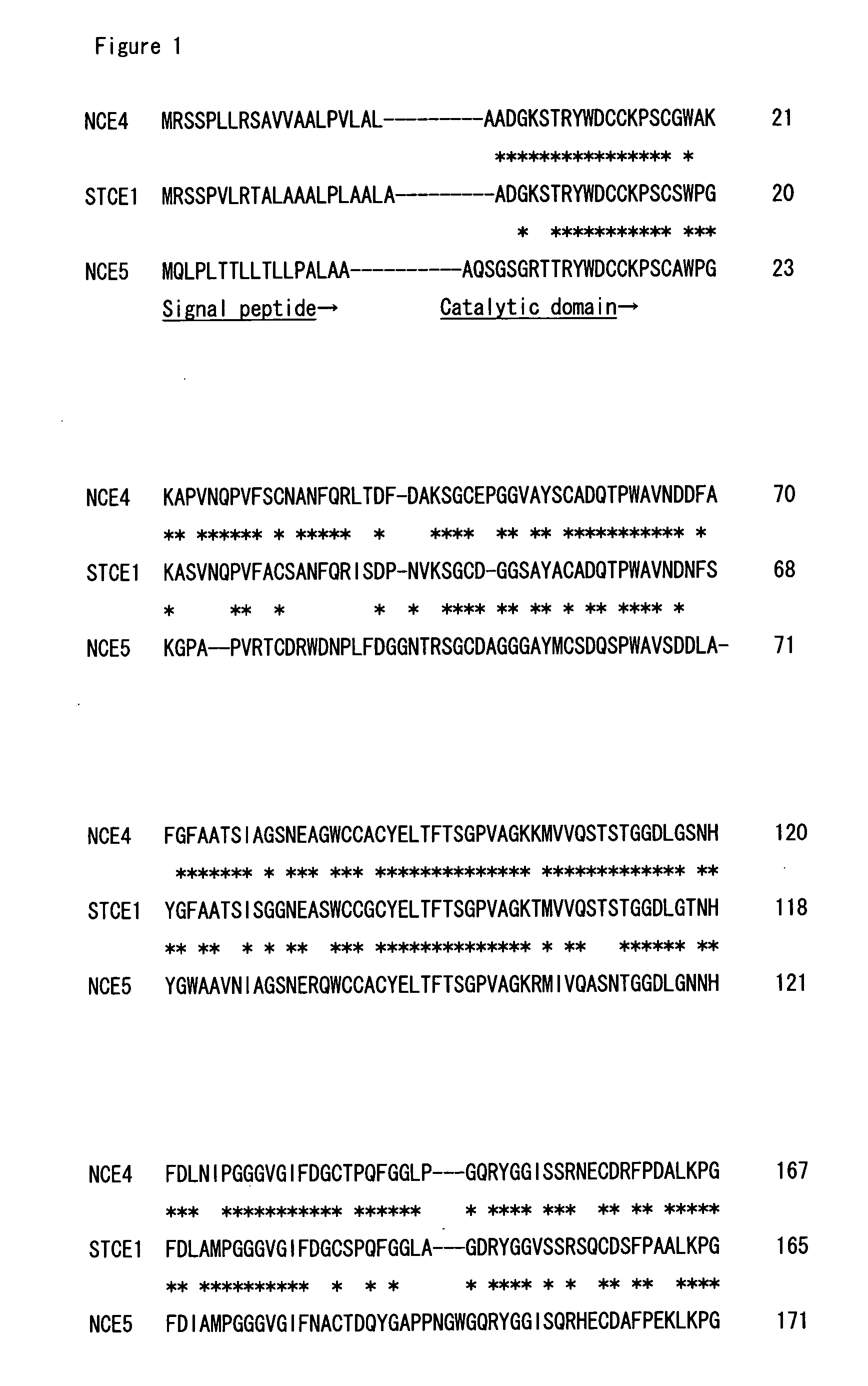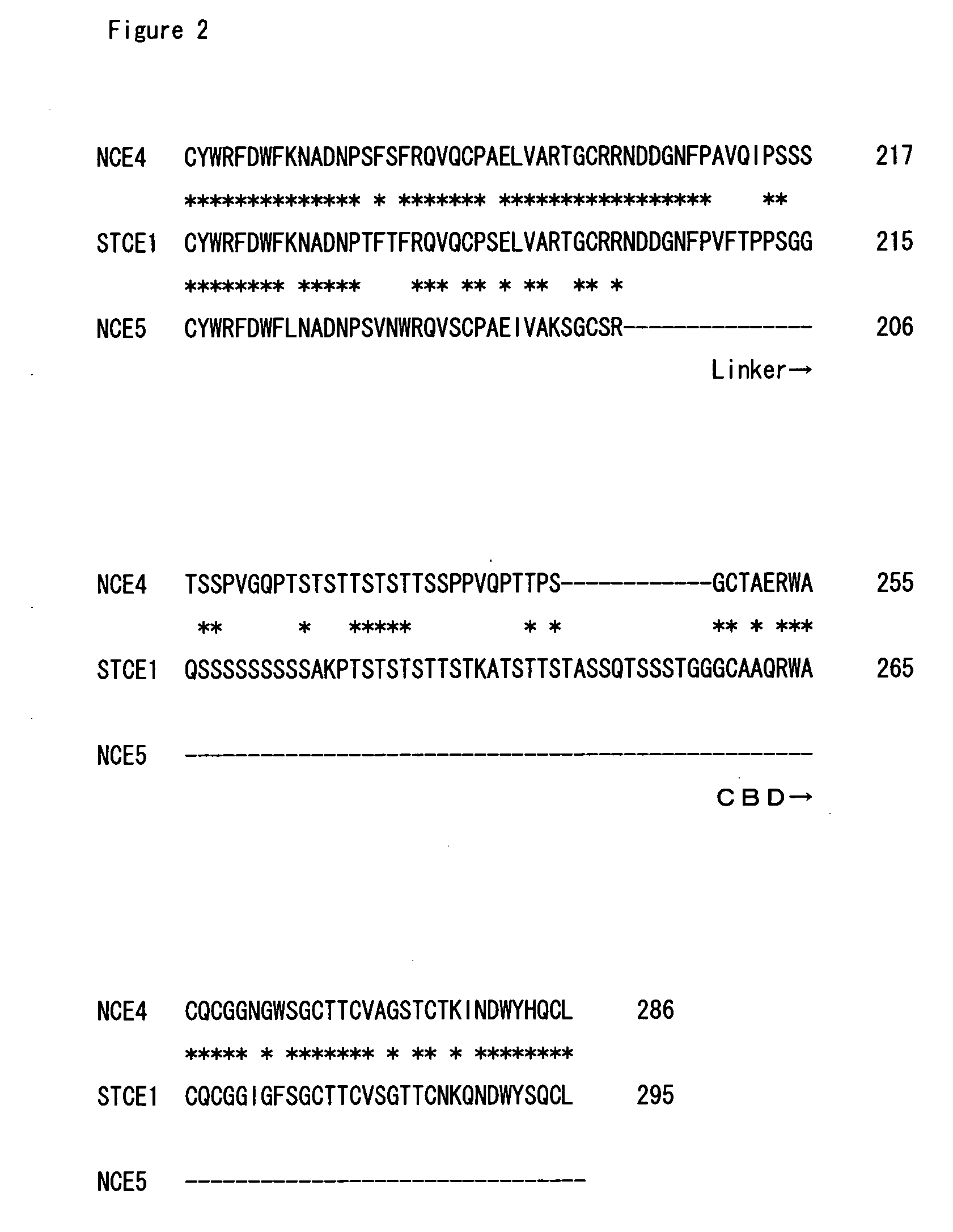Endoglucanase stce and cellulase preparation containing the same
a technology of endoglucanase and cellulase, which is applied in the field of endoglucanase stce and cellulase preparation containing the same, can solve the problems of reducing the color clarification activity, affecting the color of the colored fabric, so as to improve the touch feel and appearance of the fabric, reduce the fuzz, and reduce the stiffness
- Summary
- Abstract
- Description
- Claims
- Application Information
AI Technical Summary
Benefits of technology
Problems solved by technology
Method used
Image
Examples
example 1
Isolation and Purification of Component Having Absorbent Cotton Fibril-Releasing Activity from Staphylotrichum coccosporum
[0108]Staphylotrichum coccosporum IFO 31817 was cultivated in a (T) medium (2.0% avicel, 2.0% yeast extract, 2.0% corn steep liquor, 1.0% glucose, and 0.2% potassium phosphate) at 28° C. under shaking. After cultivation for 10 days, the mycelia were removed from the culture to obtain a culture supernatant as a crude cellulase preparation solution.
[0109] Ammonium sulfate was added to the crude cellulase preparation solution so that a final concentration of ammonium sulfate in the solution became 1.5 mol / L. The solution was applied to a HiTrap™PhenylHP column (Amersham Bioscience) equilibrated with 1.5 mol / L ammonium sulfate solution, and eluted by a stepwise elution method using 1.5 mol / L, 0.9 mol / L, 0.75 mol / L, 0.6 mol / L, 0.15 mol / L, and 0 mol / L ammonium sulfate solutions (in deionized water), to collect fractions. The fractions eluted at concentrations of 0.75...
example 2
Sequencing of Partial Amino Acid Sequences of Endoglucanases STCE1 and STCE3 Derived from Staphylotrichum coccosporum
(1) Identification of N-terminal Amino Acid Sequences of STCE1 and STCE3
[0120] The STCE1 fraction and the STCE3 fraction obtained in Example 1 were subjected to SDS-PAGE, and transferred to a PVDF membrane Problot™ (Applied Biosystems) electrically. The membrane was stained with a CBB staining solution (0.1% Coomassie blue G250, 30% methanol, and 10% acetic acid), and decolorized and air-dried. From the membrane, each portion, on which a protein (STCE1) having a molecular weight of approximately 49 kD corresponding to the STCE1 fraction or a protein (STCE3) having a molecular weight of approximately 45 kD corresponding to the STCE3 fraction was blotted, was excised. Each excised piece was moistened with a minute amount of methanol, washed with lightly a buffer for reduction (8 mol / L guanidine hydrochloride, 0.5 mol / L Tris, 0.3% EDTA-Na2, and 5% acetonitrile), and i...
example 3
Evaluation of Activity of Purified Endoglucanase STCE1 to Remove Fuzz from Cellulose-Containing Fabric
[0126] The crude cellulase preparation solution and purified endoglucanase STCE1, obtained in Example 1, were used to evaluate a fuzz-removing activity on a cotton knit fabric.
[0127] Cotton knit fabrics stained blue were treated with a surfactant and with rubber balls in a large washer to generate fuzz. The blue cotton knit fabrics with fuzz were treated under the following conditions for removing fuzz, to calculate a protein concentration required to remove approximately 50% of the formed fuzz on the basis of a visual evaluation, in each case of adding the crude cellulase preparation solution or purified endoglucanase STCE1.
[0128] Testing machine: Launder Meter L-12 (Daiei Kagaku Seiki MFG., Japan)
[0129] Temperature: 40° C.
[0130] Time: 60 minutes
[0131] Amount of reaction solution: 40 mL
[0132] Reaction pH: pH 6 (5 mmol / L phosphate buffer)
[0133] To each treating solution, app...
PUM
| Property | Measurement | Unit |
|---|---|---|
| volume | aaaaa | aaaaa |
| volume | aaaaa | aaaaa |
| temperature | aaaaa | aaaaa |
Abstract
Description
Claims
Application Information
 Login to View More
Login to View More - R&D
- Intellectual Property
- Life Sciences
- Materials
- Tech Scout
- Unparalleled Data Quality
- Higher Quality Content
- 60% Fewer Hallucinations
Browse by: Latest US Patents, China's latest patents, Technical Efficacy Thesaurus, Application Domain, Technology Topic, Popular Technical Reports.
© 2025 PatSnap. All rights reserved.Legal|Privacy policy|Modern Slavery Act Transparency Statement|Sitemap|About US| Contact US: help@patsnap.com


